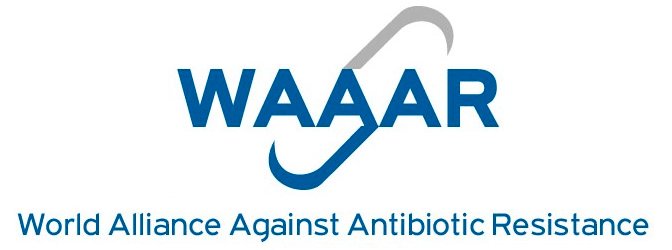WAAAR: World Alliance Against Antibiotic Resistance
Focusing on protecting Human Health Join usDiscover WAAAROur mission at WAAAR
We are endangered by the rise of antibiotic resistance.
Without antibiotics, no surgery is possible, without antibiotics, no cancer treatment. Without antibiotics, a simple bicycle fall can mean death.
Yet, Humanity is dilapidating this precious resource.
The weaknesses in the battle against antibiotic resistance have remained:
- The release of antibiotic containing waste in the environment, and of antibiotic-resistant bacteria containing waste from husbandry, continues.
- Use of diagnostic tools is low, and antibiotics are still prescribed needlessly by doctors, pharmacists, over the counter shops, hospitals, while patients request them wrong-headedly.
- The information – education campaign on the concept of antimicrobial resistance have yet to overcome misconceptions in the lay public as identified by the excellent Wellcome trust study.
- People believe that the term ‘resistance’ applies not to bacteria but to the antibiotic or to the individual patient and many believe that if they don’t take antibiotics or have proper diet, their body cannot become ‘resistant’ (sic) and therefore AMR is of no concern to them.
Recent Major Paper at the Open Forum Infectious Diseases
Trends in Antibiotic Consumption and Resistance in France Over 20 Years: Large and Continuous Efforts but Contrasting Results.
Carlet J, Jarlier V, Acar J, Debaere O, Dehaumont P, Grandbastien B, Le Coz P, Lina G, Pean Y, Rambaud C, Roblot F, Salomon J, Schlemmer B, Tattevin P, Vallet B, Open Forum Infect Dis. 2020 Nov
Our actions at WAAAR
The WAAAR has focused its action on intense lobbying to advocate the following :
Controlled use of antibiotics
Cautious, controlled and surveyed approaches to the use of antibiotics in hospitals, husbandry, agricultural and veterinary settings.
Awareness-raising
Large information and awareness campaigns directed to the public on the proper use of antibiotics. Education and training programs for health care professionals.
Prevention
Relentless efforts to prevent cross-transmission of MDR organisms (MDROs), in particular via hand hygiene, standard precautions, and isolation procedures. Progressive elimination of the “over the counter” sales of antibiotics.
Increased R&D
Increased support to basic and applied research efforts in human and veterinary medicine. Incentives to stimulate research of new drugs via fast track developments of new antibiotics.
AMR Manual
The political fight against antibiotic resistance is major a public health and sustainable developpment issue for future generations. Check out how to make a difference.
Activity report
WAAAR is established at the international level and interacts with many actors.
Check out our latest activity report!
Join WAAAR
The ACdeBMR / WAAAR (World Alliance Against Antibiotic Resistance), not-for-profit NGO, was created in 2011 in Paris, by doctors and professors, most of whom had many years of activities in research, advocacy and practice on the threat of antibiotic resistance.
WAAAR’s programs are endorsed by more than 140 learned societies or professional groups throughout the world.
WAAAR currently has 730 individual members from 55 countries (including 400 in France) covering all continents and representing all stakeholders (doctors, particularly infectious diseases specialists, hygienists, veterinarians and microbiologists; pharmacists; nurses; evolutionary biologists and ecologists.
WAAAR Declaration
The increase in antibiotic resistant bacteria poses a major healthcare threat. In the face of an almost complete absence of new antimicrobial drugs in development, antibiotic resistance (ABR) has become one of the main public health problems of our time.
Although it is a never-ended phenomenon, antibiotic resistance is directly related to the volume of antibiotics used. We are using increasing amounts of antibiotics in health care and agriculture, and discharging these active drugs into the environment. The impact of widespread antibiotic use is enormous, promoting the development and dissemination of antimicrobial resistance.
Safeguarding antibiotics will require a concerted effort by citizens, patients and prescribers. The primary goal of WAAAR is to raise awareness about the urgency and magnitude of the threat and to promote an international dialogue to assist in effective responses. The Alliance, in particular through this declaration, is dedicated to actively promoting antibiotic preservation and to raising awareness among antibiotic prescribers, politicians and policy-makers, patient safety and advocacy groups, the pharmaceutical industry, international health organizations, and the general population. Individual actions, no matter how well intended, are doomed to failure unless there is an international dialogue, a common sense of purpose, and broad consensus on how best to proceed.
We must change how antibiotics are used and adopt proactive strategies, similar to those used to save endangered species. Preservation of the efficacy of antibiotics and to stabilization of antibiotic-susceptible bacterial ecosystems should be global goals.
We urge all of you to participate in this crusade, in your own field of interest. The medical miracle of antibiotic therapy must be protected – this is a global priority and our duty. Please, help us to act NOW, by supporting this declaration, to promote wiser use of antibiotics in animal and human health, and the necessary accompanying political actions to support better education, integrated surveillance for public health action, and research.
WAAAR advocates for the following 10 actions:
Sensibilization
Promotion of awareness of all the stakeholders – including the general public – of the threat represented by antibiotic resistance.
Strong cooperation among international political, economic and public health organizations, which, all together, must take the lead of this action against antibiotic resistance.
Organization
Access
Continuous access to antibiotics of assured quality, especially in middle and low income countries
Surveillance
Integrated Surveillance of antibiotic resistance (ABR) and antibiotic use Standardized monitoring of antibiotic use and resistance at institution, regional, and country (comprehensive national data instead) level (through a Centers for Diseases Control and Prevention model) to allow comparative statistics (benchmarking), to be updated preferably in real-time and at least every 12 months. This will require adequate laboratory capacity using international standardized methods that may be facilitated by a centralized technologic coordinating infrastructure and information technology
Diagnostic
Use of diagnostic tests: appropriate use of existing diagnostic tests and development and implementation of new rapid, cost-effective and accurate diagnostic tests, adapted to the local context, to aid in distinguishing bacterial and nonbacterial etiologies. Rapid diagnostics may help clinicians avoid unnecessary treatments, rapidly select appropriate targeted therapies and inform the duration of treatment
Limitation
Antibiotic stewardship (prudent, controlled and monitored approaches to the use of antibiotics)
- In humans (hospitals, long term care facilities and primary care).
- In animals (animal husbandry, agriculture, aquaculture and animal health /veterinary setting), in a “one health” philosophy.
- Progressive elimination of the “over the counter” (i.e. available without a prescription) access to antibiotics (systemic and topicals) for humans or animals.
- Ban of the use of antibiotics as growth promotion in food animals, and exceptional use in prophylaxis.
- Rational use of metaphylaxis (Prophylaxis when some animals in the livestock are sick, or at high risk to be sick), and of animal treatment.
- Limitation of the use of critically important antibiotics in humans and animals (e.g., carbapenems)
Education
Educational efforts for change
- Educational programs directed at children/teenagers on antibiotics, bacterial resistance, and infection control (e-Bug model)
- Development of large coordinated, effective information and awareness campaigns directed at the public on expectations about the rational/appropriate use of antibiotics.
- Continuouseducation and training programs in the curriculum for all health care professionals in all settings (veterinarians, medical, dental, nursing, pharmacy and allied health care schools) and continuing professional education programs, on the rational use of antibiotics, including indications, dosing and duration of therapy. Education of farmers
Prevention
Containment of bacterial transmission and prevention of infection
- Promotion of universal hand hygiene and all infection control interventions that have been proven to reduce rates of resistance
- Relentless efforts to prevent transmission of MDR organisms in healthcare, food production and animal husbandry
- Programs to limit the contamination of drinking water with MDR bacteria, as well as contamination of the environment
- Promotion of the use of available vaccines, in humans and animals
Research
Basic and applied research, and development of new antibiotics
- Increased support for basic and applied research aiming at curbing bacterial resistance in human and veterinary medicine.
- Use of the principles of orphan drugs for new antibiotics
- Incentives to stimulate research of new drugs (antibiotics and novel compounds) and vaccines via regulatory pathways that allow for fast track development.
- New economic business models to support the cost of innovation while safeguarding public health interests.
Recognition
Request for UNESCO to include the “concept of antibiotic” in the list of the intangible cultural heritage.

